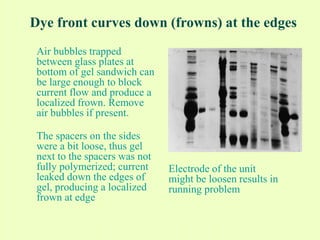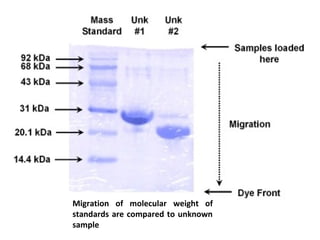Which Dye Is Used in Sds Page Technique
SDS PAGE also known as Sodium Dodecyl Sulphate-Polyacrylamide Gel Electrophoresis is a technique used for separating the proteins based on their molecular weight. The buffer contains coomassie dye enabling visualization of the electrophoretic progress by the location of the dye front.
This treatment allows the visualization of proteins as blue bands on a clear background.

. In SDS Page polyacrylamide is used as the solid support for the gel. These stains either use the G-250 colloidal or the R-250 form of the dye. Chemical polymerisation of acrylamide gel is used for SDS-PAGE.
Which dye is used in SDS PAGE technique. These gels are for SDS-PAGE the most commonly used protein electrophoresis technique. The electrophoresis apparatus used was a Mini-Protean III Gel Electrophoresis Apparatus purchased.
N N N N-tetramethylethylenediamine TEMED. Which dye is used in SDS PAGE technique. SDS-PAGE and NSDS-PAGE gels were stained using SimplyBlue Safe Stain Invitrogen.
Which of the following is used as a tracking dye in SDS-PAGE of protein. SDS to denature the polypeptides Dithiothreitol DTT to break disulfide bonds covalent bonds between cysteines Glycerol to make the sample dense enough to sink into the well Bromophenol Blue a negatively charged dye to monitor gel progress. When associated with protein it remains blue even at low pH.
Once electrophoresis is complete the gel can be stained using colored dyes such as Coomassie Brilliant Blue or ethidium bromide to make the separated proteins appear as distinct colored bands on the gel. This method is called native-PAGE. Click to see full answer.
These short objective type questions with answers are very important for competitive exams like IIT-JEE AIIMS etc. Once electrophoresis is complete the gel can be stained using colored dyes such as Coomassie Brilliant Blue or ethidium bromide to make the separated proteins appear as distinct colored bands on the gel. In this technique the proteins will be completely denatured so they will be separated on the gel only on the basis of molecular mass.
As well as Board exams. In SDS-PAGE the use of sodium dodecyl sulfate SDS also known as sodium lauryl sulfate and polyacrylamide gel largely eliminates the influence of the structure and charge and proteins are separated solely based on polypeptide chain length. The sample buffer used for SDS-PAGE contains a tracking dye bromophenol blue BPB which will migrate with the leading edge of the proteins being separated on the gel.
The gels are soaked in dye and excess stain is then eluted with a solvent destaining. These short solved questions or. LDS Sample Buffer Non-Reducing 4X is a convenient sample buffer for use in SDS-polyacrylamide gel electrophoresis SDS-PAGE.
Coomassie Brilliant Blue is the stain used to stain the protein in SDS PAGE. It can be initiated by ammonium persulfate and the quaternary amine NNNN- tetramethylethylenediamine TEMED. Electrophoresis Multiple Choice Questions and Answers for competitive exams.
Once the electrophoresis is over SDS-PAGE gel will be stained in Coomassie Stain Solution. BN-PAGE gels were microwaved for 45 seconds in fixing solution 40 methanol and 8 acetic acid and placed on a shaker for 30 minutes. Protein samples loaded on the SDS-PAGE gel will be run in SDS-PAGE Running Buffer.
Due to the negative charge protein molecules migrate toward the positive charge end of the gel and separates according to their molecular masses. The most commonly used form of polyacrylamide gel electrophoresis is the Sodium dodecyl suplhate Polyacrylamide gel electrophoresis SDS- PAGE used mostly for the separation of proteins. Alternatively a chemical denaturant may be added to remove this structure and turn the molecule into an unstructured molecule whose mobility depends only on its length because the protein-SDS complexes all have a similar mass-to-charge ratio.
Coomassie Brilliant Blue is a typical quick and dirty SDS-PAGE gel stain. Sodium dodecyl sulfate polyacrylamide gel electrophoresis. It will take approximately one hour to properly stain the SDS-PAGE gel.
The dye used was an acidic mixture of Coomassie Brilliant Blue G-250 purchased from Bio-Rad Laboratories IncHercules CA. Bromophenol blue is used as a tracking dye in SDS PAGE as well as Agarose gel electrophoresis. The gel is soaked in an acidic alcoholic solution of the dye which denatures the protein and fixes it in the gel and also complexes the dye to the protein.
The G-250 variant is a pH sensitive dye that is a very dark blue at neutral pH and a much lighter tan color at acidic pH. Glycerol is added to protein samples before they are loaded to the wells of PAGE. STAINING The gel after electrophoresis is put in a solution of Coomassie Brilliant Blue prepared in.
Gels were washed 3X in ddH 2 O for 5 minutes incubated in 100 mL of SimplyBlue Safe Stain for 1 h destained twice in 100 mL of ddH 2 O for 1 hour. The actual separation of the proteins mainly depends on the properties of the gel. The most common method of in-gel protein detection is staining with Coomassie dye.
The function of glycerol is to _____. Another technique utilized in this lab is SDS-PAGE or sodium dodecyl sulfate-polyacrylamide gel electrophoresis. Coomassie blue dyes are a family of dyes commonly used to stain proteins in SDS-PAGE gels.
As Coomassie stain also binds to SDS-PAGE gel a SDS-PAGE Destain. Colloidal Coomassie stains can be formulated to effectively stain proteins within 1 hour and requires only water no methanol or acetic acid for destaining. Bio-Rad offers Coomassie stains in four formats.
It is a widely used technique in forensics genetics biotechnology and molecular biology to separate the protein molecules based on their electrophoretic mobility. Both a and b e. For proteins the most commonly used dye is Coomassie brilliant blue.
Fluorescent proteins such as GFP wont be fluorescent on this type of gel because theyre denatured. This procedure is called SDS-PAGE.

Native Page Polyacrylamide Gel Electrophoresis Blue Native Page The Bumbling Biochemist


0 Response to "Which Dye Is Used in Sds Page Technique"
Post a Comment